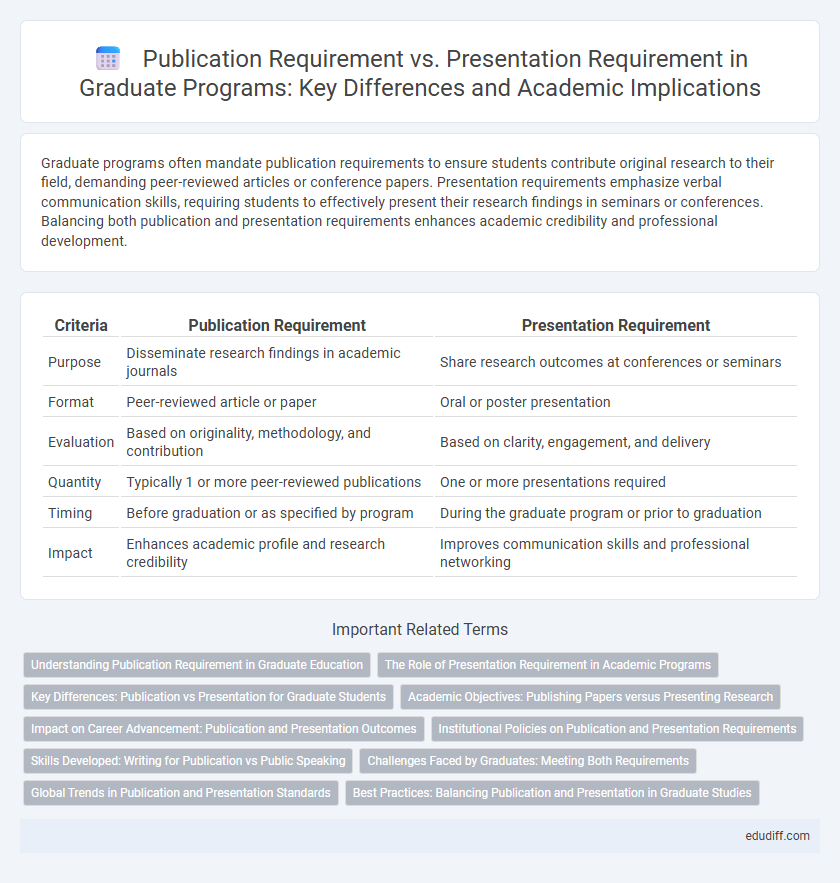Graduate programs often mandate publication requirements to ensure students contribute original research to their field, demanding peer-reviewed articles or conference papers. Presentation requirements emphasize verbal communication skills, requiring students to effectively present their research findings in seminars or conferences. Balancing both publication and presentation requirements enhances academic credibility and professional development.
Table of Comparison
| Criteria | Publication Requirement | Presentation Requirement |
|---|---|---|
| Purpose | Disseminate research findings in academic journals | Share research outcomes at conferences or seminars |
| Format | Peer-reviewed article or paper | Oral or poster presentation |
| Evaluation | Based on originality, methodology, and contribution | Based on clarity, engagement, and delivery |
| Quantity | Typically 1 or more peer-reviewed publications | One or more presentations required |
| Timing | Before graduation or as specified by program | During the graduate program or prior to graduation |
| Impact | Enhances academic profile and research credibility | Improves communication skills and professional networking |
Understanding Publication Requirement in Graduate Education
Publication requirement in graduate education mandates that students produce original, peer-reviewed research articles before graduation to demonstrate scholarly contribution and mastery of their field. This requirement enhances academic credibility and prepares graduates for professional research careers by validating their ability to communicate findings effectively. Unlike presentation requirements that assess verbal communication skills, publication emphasizes rigorous data analysis, critical thinking, and adherence to disciplinary standards.
The Role of Presentation Requirement in Academic Programs
Presentation requirements in academic programs foster critical communication skills essential for graduate success, enabling students to effectively convey complex research findings to diverse audiences. These requirements complement publication mandates by emphasizing oral proficiency and real-time engagement, which are vital for professional development and academic collaboration. Graduate programs increasingly prioritize presentations to cultivate confidence, enhance interdisciplinary understanding, and prepare candidates for conferences, job interviews, and public discourse.
Key Differences: Publication vs Presentation for Graduate Students
Graduate students face distinct expectations in publication and presentation requirements that shape their academic progression. Publication requirements prioritize peer-reviewed journals or conferences that validate research originality and contribute to the scholarly community. Presentation requirements emphasize effective oral communication skills and the ability to convey research findings clearly to academic and non-academic audiences, often through seminars or symposiums.
Academic Objectives: Publishing Papers versus Presenting Research
Graduate programs often distinguish publication requirements from presentation requirements based on academic objectives, emphasizing publishing papers in peer-reviewed journals to contribute original research to the scholarly community. Presenting research at conferences focuses on communication skills, networking, and receiving feedback, which supports the development of research dissemination and collaboration. Both processes are essential for professional growth, but publishing papers typically carries greater weight in academic evaluations and career advancement.
Impact on Career Advancement: Publication and Presentation Outcomes
Publication requirements often have a greater impact on career advancement by enhancing academic credibility and increasing citation potential, which improves visibility within research communities. Presentation requirements contribute to developing communication skills and networking opportunities, facilitating professional relationships and collaborations. Balancing both publication and presentation outcomes maximizes exposure, reinforcing a graduate's reputation and opening diverse pathways for career growth.
Institutional Policies on Publication and Presentation Requirements
Institutional policies on graduate publication requirements mandate the submission of peer-reviewed journal articles to demonstrate research competency, ensuring academic rigor and contribution to the field. Presentation requirements, often fulfilled through conference participation or departmental seminars, emphasize the development of communication skills and scholarly dissemination. Both policies aim to enhance a graduate's academic profile but differ in format, with publications offering formal validation and presentations promoting interactive engagement.
Skills Developed: Writing for Publication vs Public Speaking
Publication requirements enhance graduate students' academic writing, critical analysis, and research dissemination skills by demanding precise, well-structured manuscripts suitable for peer-reviewed journals. Presentation requirements develop public speaking, audience engagement, and visual communication abilities, preparing graduates to effectively convey complex ideas during conferences or seminars. Both skill sets are essential for academic and professional success, with publication emphasizing written communication and presentation focusing on verbal articulation and interpersonal interaction.
Challenges Faced by Graduates: Meeting Both Requirements
Graduates often struggle to balance the publication requirement, which demands rigorous research and peer-reviewed journal submissions, alongside the presentation requirement that emphasizes effective communication skills and clarity in front of an academic audience. Time management issues arise due to simultaneous deadlines, while mastering both written and oral academic standards increases stress and workload. Limited access to mentorship and resources further complicates meeting both requirements efficiently.
Global Trends in Publication and Presentation Standards
Graduate programs worldwide increasingly emphasize publication requirements as a benchmark of research quality and academic contribution, with top institutions expecting peer-reviewed journal articles in high-impact databases like Scopus and Web of Science. Presentation requirements, while still important for developing communication skills and networking, are often considered supplementary and vary widely across regions, with conferences such as IEEE and ACM serving as key platforms for knowledge dissemination. Global trends show a shift towards integrating open-access publishing and virtual presentations to enhance accessibility and international collaboration among graduate students.
Best Practices: Balancing Publication and Presentation in Graduate Studies
Balancing publication and presentation requirements in graduate studies demands a strategic approach that prioritizes quality over quantity. Emphasizing peer-reviewed journal articles enhances academic credibility, while regular conference presentations foster professional networking and constructive feedback. Incorporating both elements ensures comprehensive skill development and strengthens a graduate's academic and professional profile.
Publication Requirement vs Presentation Requirement Infographic

 edudiff.com
edudiff.com